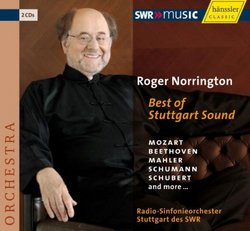| All Artists: Felix [1] Mendelssohn, Wolfgang Amadeus Mozart, Ludwig van Beethoven, Edward Elgar, Hector Berlioz, Gustav Mahler, Richard [Classical] Wagner, Pyotr Il'yich Tchaikovsky, Franz [Vienna] Schubert, Gustav Holst, Anton Bruckner, Roger Norrington, SWR Stuttgart Radio Symphony Orchestra Title: Best of Stuttgart Sound Members Wishing: 0 Total Copies: 0 Label: Hanssler Classics Original Release Date: 1/1/2009 Re-Release Date: 1/13/2009 Album Type: Import Genre: Classical Styles: Opera & Classical Vocal, Forms & Genres, Serenades & Divertimentos, Historical Periods, Classical (c.1770-1830), Early Music, Symphonies Number of Discs: 2 SwapaCD Credits: 2 UPC: 4010276021445 |
Search - Felix [1] Mendelssohn, Wolfgang Amadeus Mozart, Ludwig van Beethoven :: Best of Stuttgart Sound
 | Felix [1] Mendelssohn, Wolfgang Amadeus Mozart, Ludwig van Beethoven Best of Stuttgart Sound Genre: Classical
From Roger Norrington: "All my concerts and recordings with the Stuttgart Radio Symphony Orchestra are characterized by a serious attention to historical playing style, which has up to now normally been associated only wit... more » |
Larger Image |
CD Details
Synopsis
Album Description
From Roger Norrington: "All my concerts and recordings with the Stuttgart Radio Symphony Orchestra are characterized by a serious attention to historical playing style, which has up to now normally been associated only with period-instrument orchestras. The central, and most revolutionary, feature of our style is our adoption of the sound of earlier times. We play with the `pure tone' so much talked about by the old masters before the arrival of 20th century vibrato. This beautiful, warm tone was the normal sound of every orchestra from Bach's time to Mahler's. The honest, expressive `noble cantilena' of pure tone seems to us crucial in the performance of their music. This recording gives you the opportunity to hear how a modern symphony orchestra can reconnect with its roots and embrace the traditions of the past."

 Track Listings (12) - Disc #1
Track Listings (12) - Disc #1